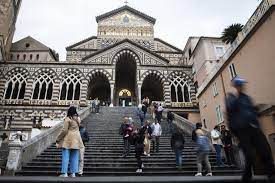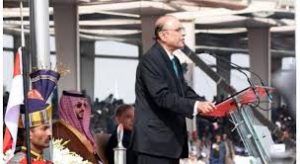How COVID accelerated the collapse of religious practice in Italy

Rome: The relentless process of secularization sweeping across Europe spares no country of Latin Catholic tradition, albeit more slowly and insidiously in some cases.
Italy, still relatively unscathed by the presence of the Vatican in its midst, is nevertheless following the same trajectory as its European neighbors.
According to the latest figures published by the Italian National Institute of Statistics (Istat), Catholics attending Mass at least once a week have decreased by almost half in two decades, dropping from 36.4% to 18.8% between 2001 and 2022, with a notable acceleration of the trend from 2020 onward.
The data showed that the closure of churches during the COVID-19 health crisis drove away a number of worshippers who did not return after the restrictions were lifted. In 2022, 31% of the population claimed not to have entered a church except to celebrate a wedding, baptism or funeral — compared with 16% in 2001. These figures are unprecedented in Italy’s history.
Nevertheless, for observers of Church life in the country, these announcements come as no surprise and appear rather optimistic given what they observe.
According to Catholic academic Marco Ventura, quoted by the Italian-language Settimana News website, “The weekly appointment in a place of worship — for Catholics the Sunday Mass — attracts fewer and fewer Italians.”
Such observation is reinforced by the generational aspect of this decline, which mainly affects the 18-24 age bracket and teenagers primarily between the ages of 14 and 17, with two-thirds of these groups having deserted church pews.
“I’ve long thought that Italy is two generations behind France, its closest neighbor,” Father Stefano Cascio, of Rome’s San Bonaventura parish since 2016, told the Register. A French-Italian national, the 45-year-old priest is known for his missionary dynamism and his popularity with young people in the often-dangerous neighborhood where his church is located.
He witnesses on a daily basis the same mechanisms observed in the France of his childhood and which have led to the Eldest Daughter of the Church becoming a country where barely 6% of the population declares themselves to be practicing Catholics.
“In France, our grandparents were generally very religious and all family celebrations were religious, but our parents, although they made us do our catechism and the sacraments, were already no longer going to Mass; it was the May ’68 generation,” he remembered. “In the next generation, namely mine, many people didn’t get married or even baptized their children.”
He witnessed firsthand a clear disengagement towards the Church in Italian society, resulting in a gradual dissociation between the life of faith and everyday life, with a growing number of Massgoers making life choices often at odds with the Church’s basic teachings.
“It was only natural that the situation would eventually explode, because tradition without faith is infertile, and with the demographic collapse, things are unlikely to get any better soon,” the priest said.
In this general context, which was already very unfavorable to the maintenance of the faith, the various lockdowns and other restrictions put in place between March 2020 and May 2022 as part of the health and political crisis triggered by COVID-19, completed the hemorrhage.
Indeed, churches remained closed for many months in 2020, depriving the faithful of access to the sacraments, and often of contact with their priests, leading many to feel abandoned in the face of the prospect of illness and in some cases death. On March 12, 2020, the Italian Bishops’ Conference was one of the world’s first to publicly consider closing churches “not because the state would impose it but out of a sense of belonging to the human family.”
In his analysis of the data from the Italian National Institute of Statistics, sociologist Franco Garelli showed the direct impact of the COVID period on religious practice, which fell by just under a third between 2001 and 2019, then by 25% between 2020 and 2022. In particular, he calculated that among teenagers, assiduous churchgoers fell from 37% in 2001 to 20% in 2019 and then to 12% in 2022.
“The COVID period was a time of abandonment by the Church, whose leaders denied people religious comfort not so much as consolation but as a reason for hope beyond physical care and health,” Riccardo Cascioli, editor-in-chief of the Catholic website La Nuova Bussola Quotidiana (“New Daily Compass”), told the Register.
Referring to periods of great plague epidemics, during which the Catholic Church was a fundamental point of reference, sparking mass conversions with their share of miracles, he lamented the loss for the whole institution of a crucial opportunity of mission and proclamation.
“This health crisis has provided an emblematic picture of the secularization that has also struck the Church itself,” Cascioli commented. “Hearing bishops assert that health takes precedence over everything else has led many people to think that churches were nothing more than places where services are dispensed, like so many other places, devoid of any reference to an eternal life that would also preside over our earthly life.”
If the fatalistic nature of these analyses is tempered by the still-majority position of Catholicism in Italy, which is still claimed by 70% of its citizens (compared to less than 60% in Spain, 25% in France and 20% in the Netherlands), it is above all because of the country’s virtual indissolubility from its Christian history.
Quoting Cardinal Camillo Ruini, Cascioli emphasized that the Italian exception has always been linked to the presence of the Vatican in its midst, as well as to the unique testimony of Christian civilization in every corner of its territory.
Yet, in his opinion, the symptoms of decadence among the population are identical to those seen in the rest of Europe. He believes, as did John Paul II, that what matters in judging the degree of faith in a society, over and above sociological data, is the propensity to make it a criterion through which life in all its different aspects is perceived.
“This is what John Paul II meant when he said that faith must become fully cultured, that it must condition our way of thinking and living,” he added, also mentioning the example of the famous Italian politician Venerable Giorgio La Pira, who was very involved in international diplomatic initiatives to promote peace in the 1950s and ’60s.
“He always said that, since he believed that Christ had risen, his whole way of looking at the realities of the world was affected by that, and he always kept this in mind when dealing with his interlocutors, whether they were communists, Muslims, Jews, atheists …”
Without such a fundamental presupposition, he concluded, faith can only be reduced to “a mere personalist and intimate cult, without any impact on society.”





